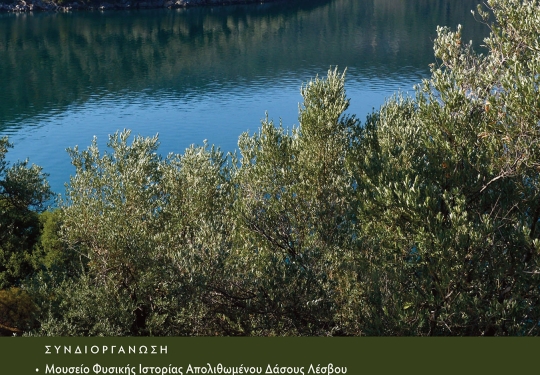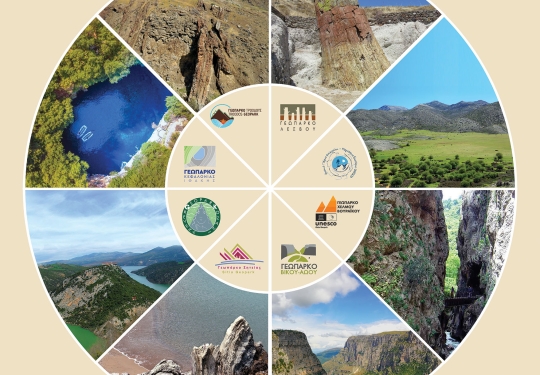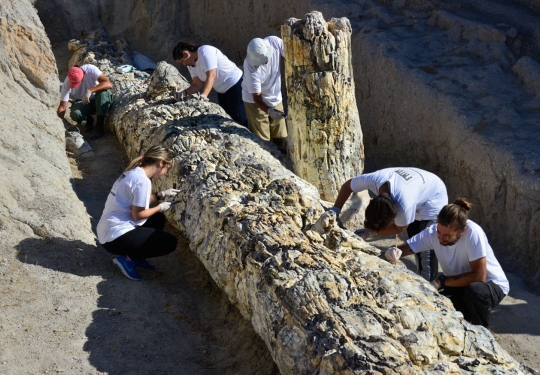Treasures of the Lesvos Petrified Forest
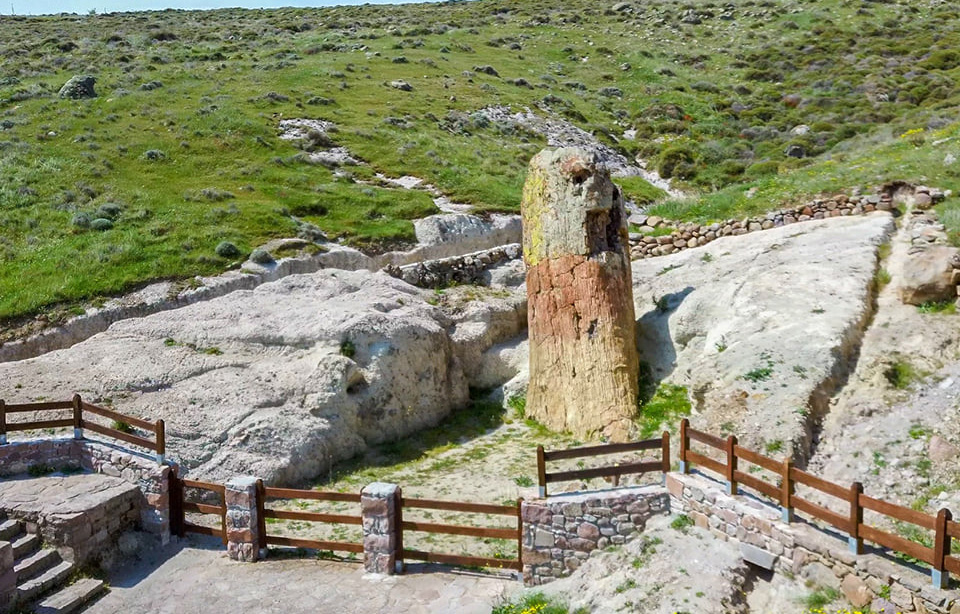
Exhibition SECTIONS
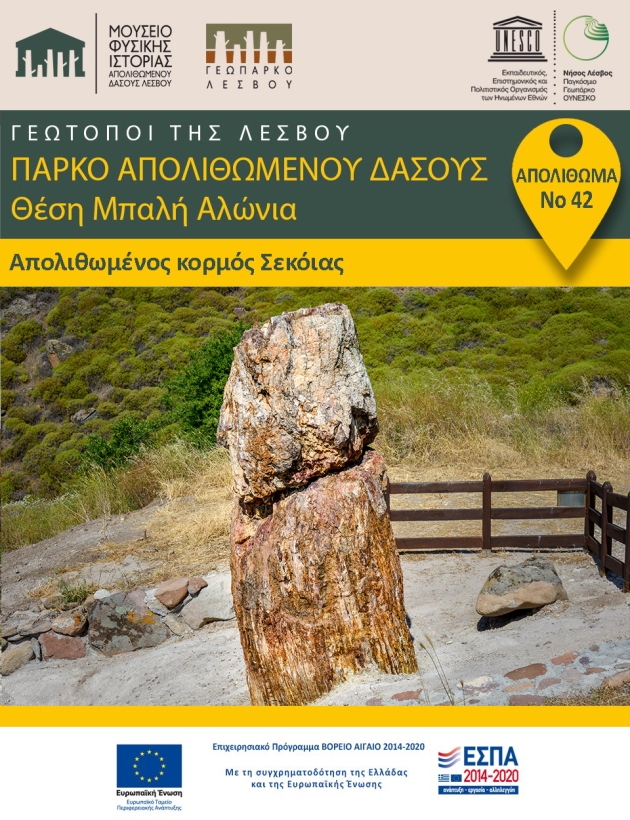
Fossil tree No 42 – Sequoia
Along the main thematic trail “walking along the sequoia forest” in the Lesvos Petrified Forest Park at Bali Alonia the visitor meets clusters of standing and lying sequoia tree trunks 20 million years old, fossilized in their natural position.
One of the most remarkable fossils is the petrified tree trunk no 42 with vivid colors. This large standing conifer tree has impressive red-brown colors and perfectly preserved morphological characteristics of the wood. The trunk belongs to the Taxodiaceae family, on species Taxodioxylon gypsaceum, an ancestral form of the modern species Sequoia sempervirens. The tree trunk is 2,52m high and it’s circumference is 3,75m. At this particular location in the park it appears that once existed a dence Sequoia forest which is slowly being uncovered in the course of excavations.
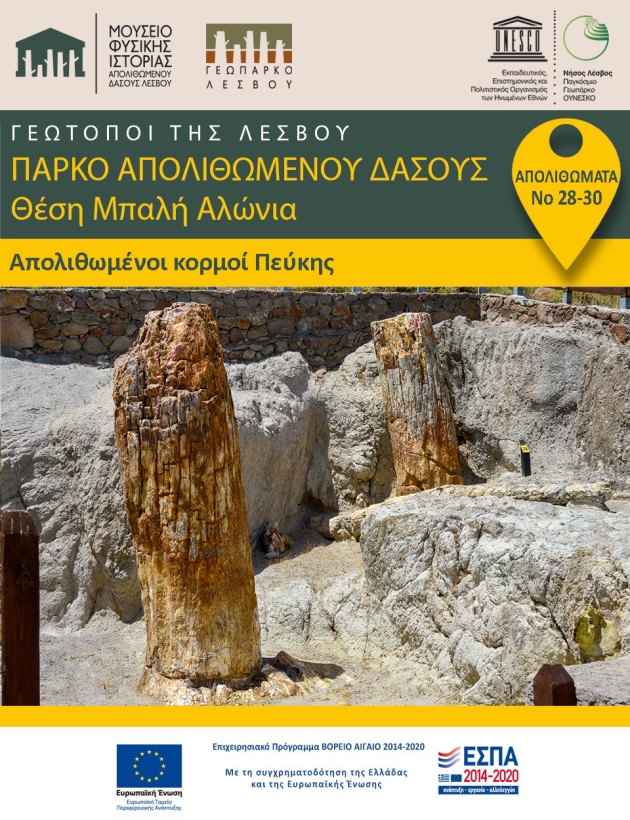
Fossil Tree Trunks No 28-30
An impressive cluster of petrified trees is visible at the petrified forest park.
The perfectly preserved petrified tree trunks represent primitive pines (Pinoxylon paradoxum), that belong to the Protopinaceae family have been unearthed due to excavations conducted by the Natural History Museum of the Lesvos Petrified Forest.
The first tree trunk Νο 29, is 2,66m high and 2,90m perimeter, with impressive colours and perfectly preserved the internal structure of the wood. The second tree trunk No 28, is also a primitive pine 2,20m high and 2,50m perimeter. Among the standing tree trunks excavations uncovered a lying sequoia tree trunk 4,90m long - Νο 30, covered by the pyroclastic material

FOSSIL TREE ΤRUNK No 16
Τhe “twin” petrified tree trunk is one of the characteristic fossil trees visible along the main trail in the Lesvos Petrified Forest Park at Bali Alonia.
Ιt is characterized as twin tree trunk since two petrified trunks branch out from a single root system. The fossil belongs to the family of primitive pines (protopinaceae), ancestor’s of today’s pine. The trunk displays a variety of coloration and clear annual growth rings. It is 1,40 m high and it’s circumference is 4 m. the upper part of the root system is also visible.
A big part of the brunches lays next to the main trunk.

Fossil Tree Trunks No 51-52
Along the main thematic trail “walking along the sequoia forest” in the Lesvos Petrified Forest Park at Bali Alonia the visitor meets clusters of standing and lying sequoia tree trunks 20 million years old, fossilized in their natural position.
One of the most remarkable fossils is the petrified tree trunk no 51 with vivid colors, surrounded by pyroclastic materials. This large standing conifer tree has impressive red-purple color, clear annual rings and perfectly preserved morphological characteristics of the wood.
The trunk belongs to the Taxodiaceae family, on species Taxodioxylon gypsaceum, an ancestral form of the modern species Sequoia sempervirens.
In front of the trunk a lying part of a big tree branch no 52, measuring 60cm of another neighboring tree trunk.
Behind the standing tree trunk lays a second broken branch which probably belongs to the tree trunk No 51.
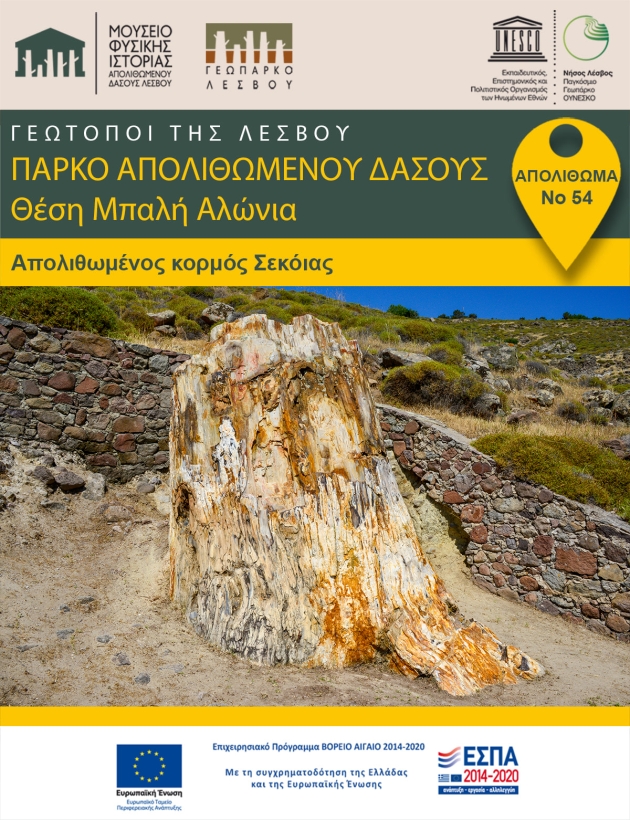
Fossilized Tree Νο 54
One of the impressive petrified trees of the Lesvos Petrified Forest Part at Bali Alonia can be found along the main thematic trail “walking along the sequoia forst” Pain where the visitor can admire giant Sequoia trees, 20 million years old - fossilized in their natural position, is the petrified tree trunk no 54. The fossil tree trunk is a standing fossilized tree trunk with impressive colors, surrounded by pyroclastic materials. The visible part of the trunk is 2.90 meters high and the perimeter is 6.70 meters. It belongs to Sequoia family and more specifically in the species Taxodioxylon gypsaceum, an ancestor of today’s Sequoia. The trunk has distinct annual rings and excellent preservation of the of the characteristics of the wood. The lower part of the trunk has been preserved with its root system, an indication that the trunk has been fossilized in its natural position.
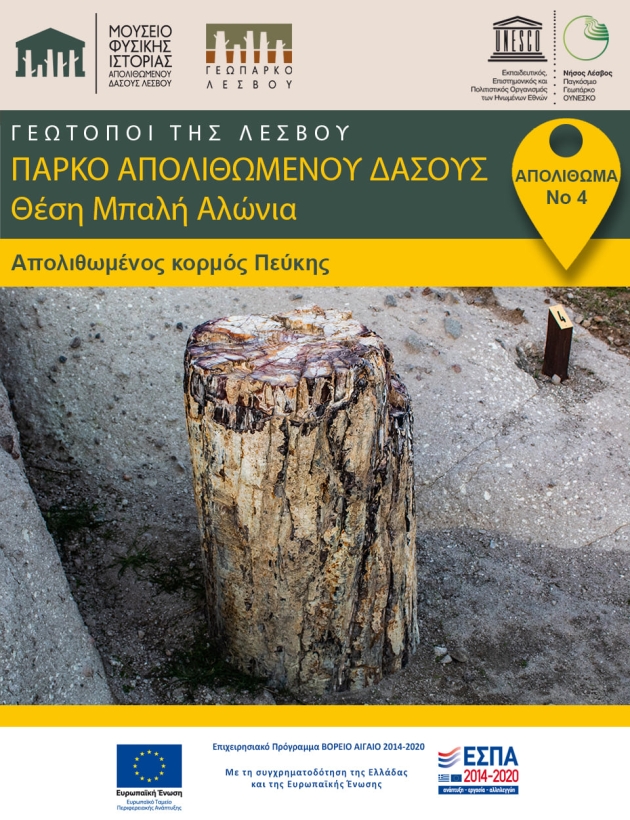
Fossil Tree Νο 4
An impressive fossil tree trunk welcomes the visitors at the start of the walking pathway in the Petrified Forest Park at Bali Alonia.
The petrified tree trunk is surrounded by pyroclastic materials created by volcanic eruptions that covered the vegetation 20 million years ago.
The tree trunk is standing in its original growing position and is characterized by the perfect preservation of the characteristics of the wood.
Τhe tree trunk belongs to a Pine species (Pinoxylon paradoxum), which belomgs to the Protopinaceae family an ancestor of today’s pine.
The visible part of the tree trunk is 1m tall and the perimeter is 2,30 m. It is characterized by the easily distinguishable growing rings.
The trunk displays varied coloration due for the most part to trace elements in the siliceous solution that caused fossilization.

Fossilized Pine Tree No 20
In the upper part of the Petrified Forest Park we find clusters of ancestral pines. Τhe visitor can observe the lower part of a primitive pine tree trunk and its root system in the pyroclastic material. In the interior of the trunk there are characteristic large-scale annual rings, showing the rapid growth of the trunk. The trunk belongs to the Protopinaceae family. The bright colours of the petrified trunk are not created by the natural wood colour, but due to the presence of oxides (iron FE, cooper Cu, manganese Mn etc.) in the hydrothermal fluids which circulated within the pyroclastic material and resulted in the tree’s silicification. The ancestor pine tree clasters have an international significance the Park is the site where this species was first identified. The protective walls and fencing around the fossil were removed in the frame of highlighting the fossil site, and they replayed with new wooden fences.
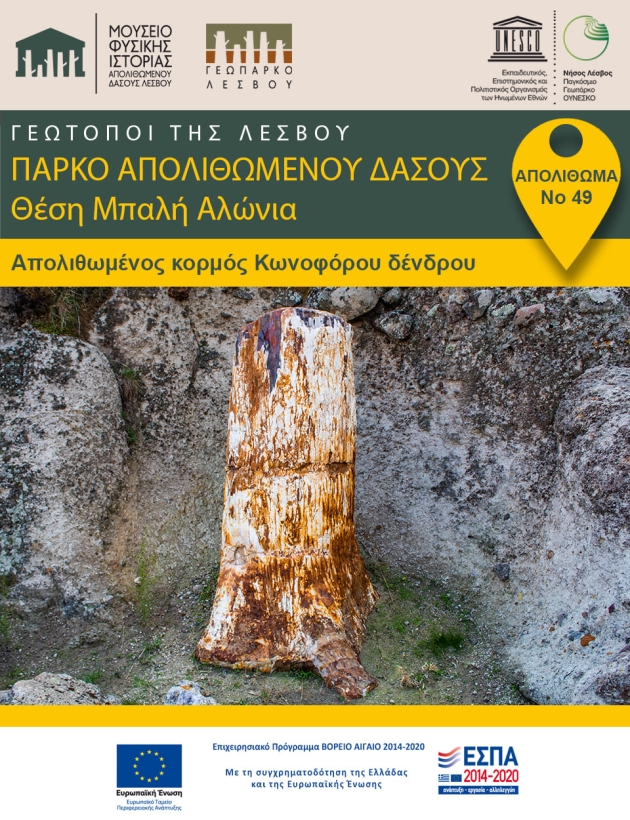
Conifer Tree Trunk No 49
Walking to the longest walking path of the Petrified Forest park, the visitor can walk through the "Sequoia Forest", developed in the area 20 million years ago. Along the main path the visitor meets the largest coniferous tree trunks in the entire park!
At the bottom of the small valley crossing the park, there is an interesting cluster of conifer trees. One of the characteristic tree trunks, is a standing fossilized trunk of a coniferous tree witch lays in its growing position with its root system has been exposed. The trunk has bright colors and its height reaches 1.80 meters.
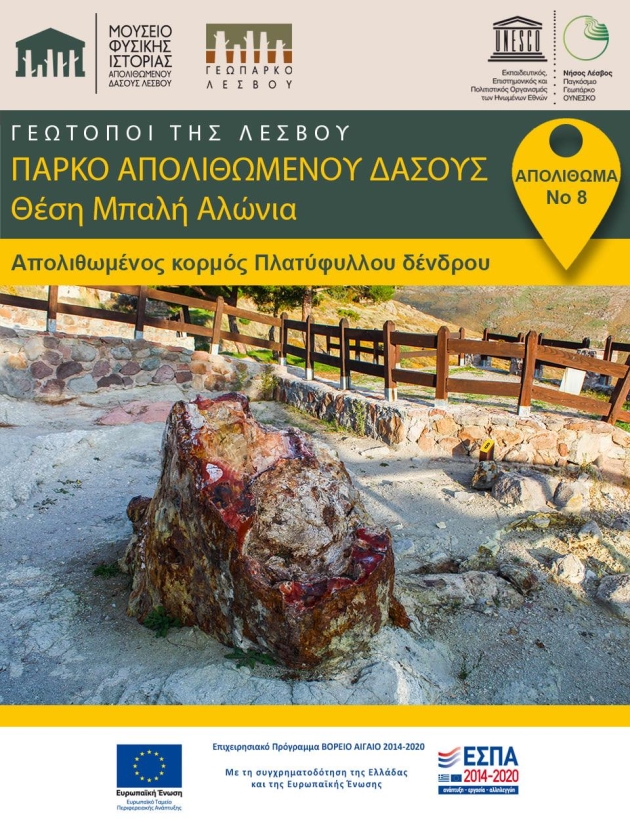
Broadleaf Fosilized Tree Trunk – 8
The lower section and root knot of a standing petrified trunk of a broadleaf tree characterized by intense colouring. The root system proves that the Petrified Forest is in its original location.
In the interior of the trunk there are characteristic large-scale annual rings, showing the rapid growth of the trunk. The intense colours of the petrified trunk are due to oxides (iron FE, cooper Cu, manganese Mn etc.). Small amounts of these oxides were contained in the hydrothermic solution which imbued the wood when it got covered by pyroclastic material and resulted in the tree’s petrification. The visible part of the root system continues down into the volcanic material.
The recent conservation works of the fossiliferous sites in the Petrified Forest Park at Kyria Apolithomeni restored the natural beauty of the fossil tree trunks. The protective walls removed away from the fossil trunk, highlighting the fossil site.
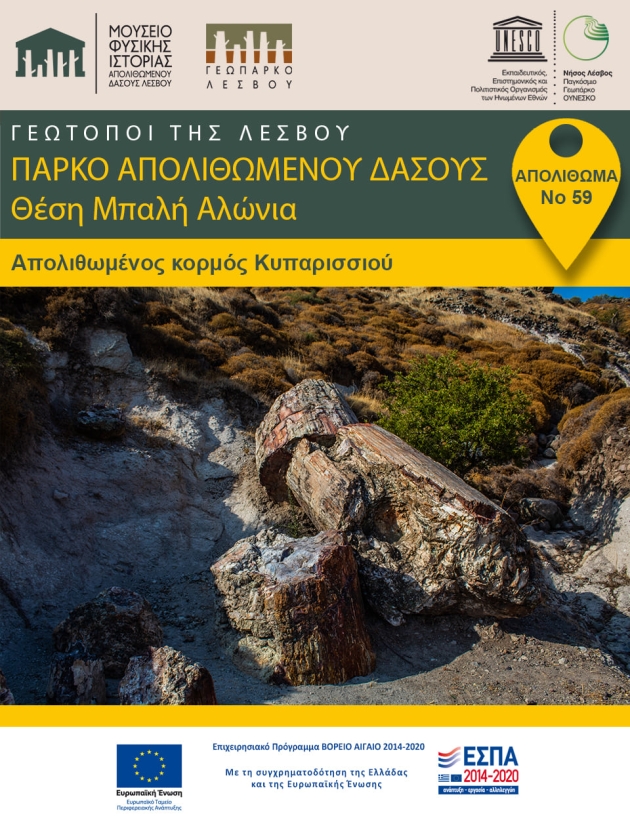
Fossilized tree trunk 59
Giant fossilized trunk of an ancestral cypress. A big fragmented cypress petrified tree trunk from the Petrified Forest Park at Bali Alonia site, the historic site of the Petrified Forest of Lesvos.
The total length of the trunk that has been revealed by the natural erosion and excavation works is 4.55 meters and its diameter is 1.20 meters.
This is a new species of tree that was identified for the first time in the Park of the Petrified Forest of Lesvos. The new species Tetraclinoxylon velitzelosii, belongs to the family of Cupressaceae, to which belong the modern species of cypress.
The trunk is broken into three pieces at its base. Next to it’s lower part which appears in its growing position, lie the upper part of the trunk broken into two large pieces.
The fossilized trunk retains the original characteristics of the wood, which led to the recognition of the species. The visitor can observe distinct features of the tree such as the trunk surface and the growth rings.
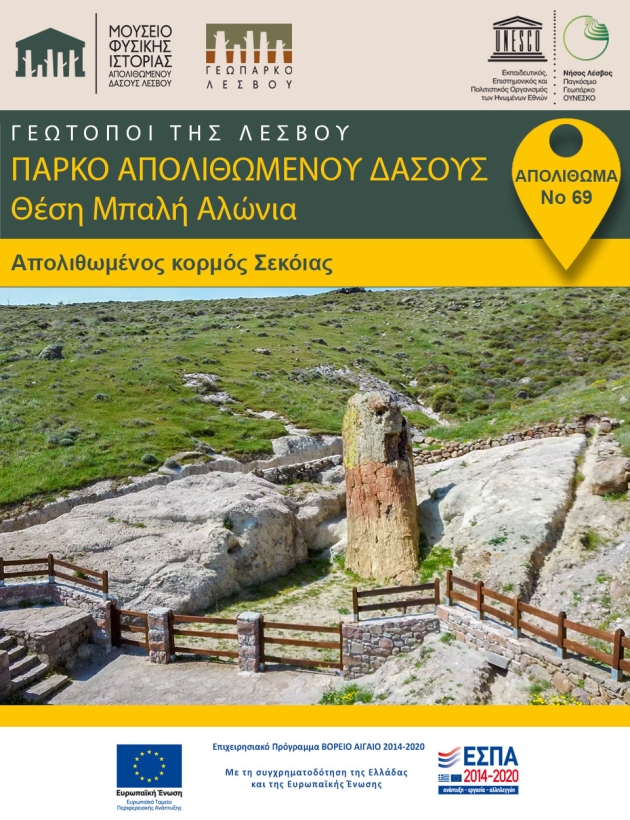
Fossil Tree Trunk 69
The biggest standing fossilized tree trunk in the world!
The work of highlighting the largest standing fossil tree trunk in the world completed, revealing to the visitor's eyes the impressive image of the giant trunk surrounded by layers of volcanic ash. The tree trunk revealed at a height of 7.20 m while its perimeter is 8.58 m and belongs to Taxodioxylon albertense, an ancestral form of sequoia tree. Its modern representative Sequoia semprevirens, is found in national parks in California and Oregon.
The works of the fossil site maintenance, the cleaning and the aesthetic restoration of the trunk and it’s the conservation using completely reversible interventions gave special glamour to this unique monument of nature. The protective walls were removed in the frame of highlighting the fossil site. A rainwater drainage network was constructed as well as new wooden protective fences.
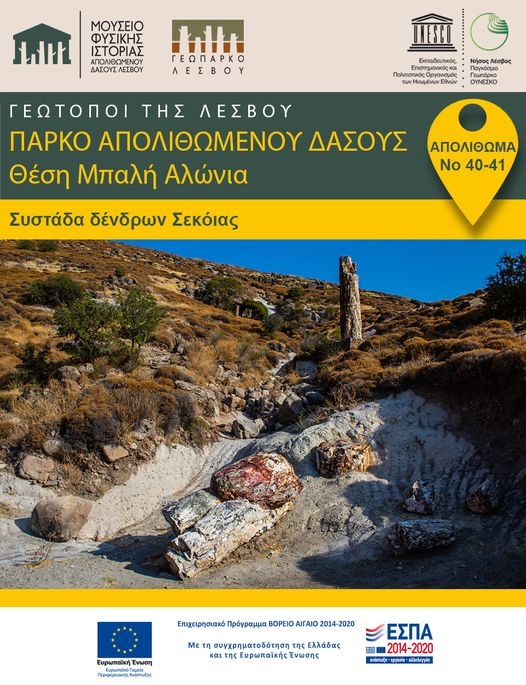
A cluster of standing sequoia petrified tree trunks
A cluster of standing sequoia petrified tree trunks dominate at the lower part of the Petrified Forest Park at Bali Alonia.
The front tree trunk No 41 was unearthed due to the natural erosion and the excavation and conservation works at the Park conducted by the Natural History Museum of the Lesvos Petrified Forest. Τhe upper part of the tree trunk which is 2,5 m long, was broken and lies next to the lower part of the trunk, it’s visible part is 63 cm, remains in its growing position and is embedded in pyroclastic material.
The petrified tree trunk has excellent preservation of the structure and characteristics of the wood such as growing rings and impressive colors.
Behind this tree trunk lies the emblematic tree trunk No 40, which was unearthed due to the natural erosion. It is 4,50 m high with a perimeter of 3,70 m.
The fossil represents a young tree that belongs to the species Taxodioxylon gypsaceum. The species Taxodioxylon gypsaceum together with the spieces Τaxodioxylon albertense, are ancestors form of the modern sequoia - Coastal Redwood which is growing at the western coast of the United States in California and Oregon.
The works at the Petrified Park at Bali Alonia gave to the visitors the opportunity to admire an impressive cluster of fossil trees in their growing positions that lived in Lesvos 18,5 million years ago.
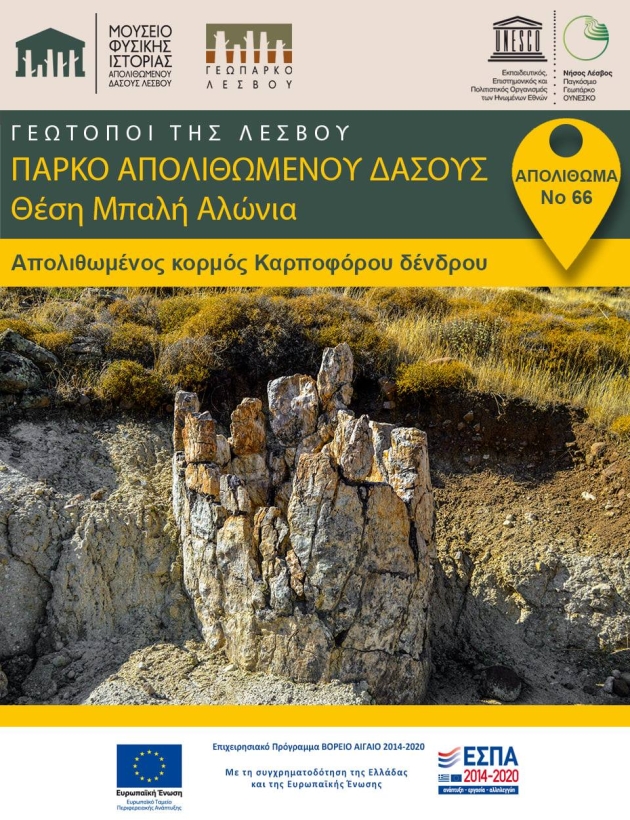
Fossil 66
Reconstruction of a petrified tree trunk of a broadleaf tree.
The recent excavation and conservation works of the fossiliferous sites in the Petrified Forest Park at Kyria Apolithomeni, led to the discovering and reconstruction of an impressive fossilized trunk of an angiosperm tree. Fragments of the petrified tree trunk were found within the upper soil horizon, during the opening of a path.
Careful excavation works followed and the lower part of the trunk was uncovered in its growing position Conservation and restoration work that followed included the collection of the fragments, their cleaning and identification of the fragments as well as restoration of the original tree trunk.
The excavation works revealed the lower part of the standing fossilized trunk. In the internal part of the trunk a significant amount of pyroclastic material was found, which leads to the conclusion that in the trunk of the tree there was an open cavity filled with volcanic material before the fossilization. The conservation team of the Museum made possible the reconstruction of the trunk creating a new important testimony of the fossil flora of Lesvos.

Petrified tree trunk No 58 – Sequoia
Part of a sequoia petrified tree trunk from the Petrified Forest Park at Bali Alonia site, the historic site of the Petrified Forest of Lesvos. The tree trunk was unearthed due to the natural erosion and the excavation and conservation works at the Park conducted by the Natural History Museum of the Lesvos Petrified Forest.
It belongs to the species Taxodioxylon gypsaceum ancestor form of the modern sequoia - Coastal Redwood which is growing at the western coast of the United States. The petrified tree trunk has excellent preservation of the structure and characteristics of the wood such as growing rings and impressive colors.
Other Exhibitions

